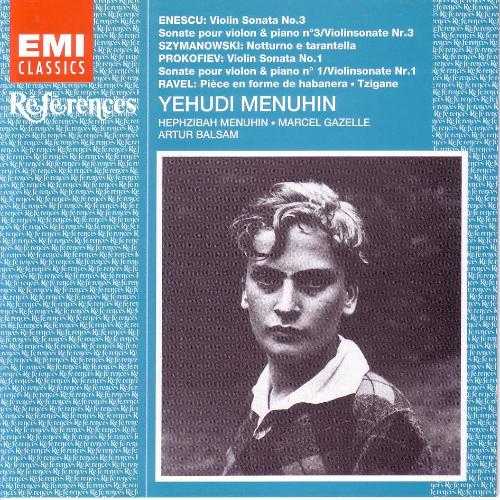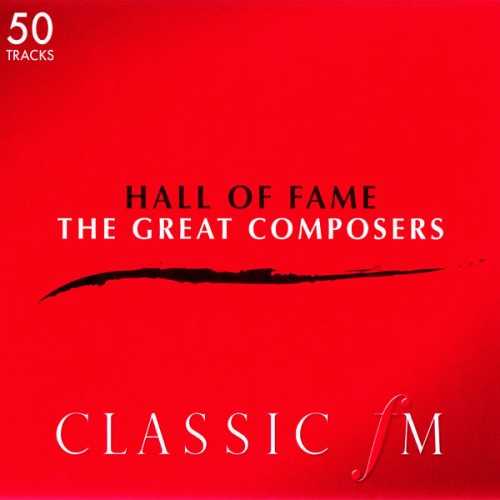
Performer: Artur Balsam, Hephzibah Menuhin, Marcel Gazelle, Yehudi Menuhin
Composer: George Enescu, Sergey Prokofiev, Maurice Ravel, Karol Szymanowski
Audio CD
SPARS Code: A-D
Number of Discs: 1
Format: APE (image+cue)
Label: EMI Classics
Size: 139 MB
Recovery: +3%
Scan: yes
01. I Moderato Malinconico
02. II Andante Sostenuto E Misterioso
03. III Allegro Con Brio Ma Non Troppo Mosso
04. Notturno E Tarantella, Op.28
05. I Andante Assai
06. II Allegro Brusco
07. III Andante
08. IV Allegrissimo/Andante Assai, Come Prima
09. Piece En Forme De Habanera
10. Tzigane, Rapsodie De Concert
# Sonata for violin & piano No. 3 in A minor (“dans le caractere populaire roumain”), Op. 25
Composed by George Enescu
with Yehudi Menuhin, Hephzibah Menuhin
# Nocturne & Tarantella for violin & piano, Op. 28, M30
Composed by Karol Szymanowski
with Marcel Gazelle, Yehudi Menuhin
# Sonata for violin & piano No. 1 in F minor, Op. 80
Composed by Sergey Prokofiev
with Marcel Gazelle, Yehudi Menuhin
# Vocalise-Étude en forme de Habanera, for voice & piano
Composed by Maurice Ravel
with Marcel Gazelle, Yehudi Menuhin
# Tzigane, rhapsodie de concert, for violin & piano (or orchestra)
Composed by Maurice Ravel
with Yehudi Menuhin, Artur Balsam
An invaluable historical document, and an indispensable one for any admirer of Menuhin
This marvellous compilation, published in 1996 by Emi “References”, is a welcome reminder not only of how talented young Yehudi Menuhin was in those early years, with unblemished purity of tone (later on, perhaps through some weakening of the bowing arm, his tonal production acquired an uningratiating wiriness), but also of his unflinching involvement with the music of his time. He was closely related to another composer not featured here, Ernest Bloch (who wrote his Abodah for the 12-year-old Menuhin, as well as the late Solo Violin Suites), and to Enescu, whom he studied with. Later of course he became a champion of Bartok.
Featured on this disc is the first recording ever of Enescu’s magnificent 3rd Sonata “Dans le caractère populaire roumain” (In the Rumania Folk Character) from 1926. According to the notes, Menuhin and his sister Hepzibah had secretly learnt the piece and played it as a gift to the composer. Enescu, who besides being a composer was one of the greatest violinist of his time, later twice recorded the Sonata, once in 1943 with Dinu Lipatti (briefly available on a 2 CD-set from the Philips Legendary Classics series) and again with Céliny Chailley-Richez. The Menuhins also re-recorded the Sonata, 30 years after their first essay, as a complement to Menuhin’s collaboration with Ravi Shankar (West Meets East: The Historic Shankar/Menuhin Sessions).
With the “Impressions d’Enfance” (1940), also for Violin and Piano, the Sonata is possibly the composer’s towering masterpiece, equal to anything that was written for these two instruments in the first half of the 20th Century. There, the composer invented a uniquely personal sound-world, inspired by Rumanian Gipsy music, rhapsodic and whimsical, and displaying a wide array technical effects used for their unique coloring and expressive possibilities: trills, mordents, acciaccaturas (also in the piano writing, lending it a unique, “aquatic” quality), upward portamentos, quarter tones, harmonics, non vibrato playing, sul ponticello (on the bridge), striking with the tip of the bow. Not surprisingly, the Menuhins turn out a reading that is stylistically very close to the composer’s own with Lipatti, though more spacious in the brooding passages, but as playful as him in the more animated ones. In the second movement, Menuhin is more spacious than in his 1966 remake and, above all, infinitely superior to his future self in the beauty of his tone production. The two partners hurl enthusiastically into the finale, with a tempo that is faster than the composer’s own, losing along the way some of the music’s rustic flavor. Only in the final page does Menuhin sacrifice some beauty of tone for the sake of raw expressivity. This is of course no hi-fi sound, though everything comes out very clearly, and it remains an invaluable historical document.
I bought this disc for the Enescu and to me all the rest is bonus. It is great to have Menuhin playing (with Marcelle Gazelle in 1935) some Szymanowski (the only that he recorded), although the “Nocturne and Tarantella” op. 29 isn’t as mesmerizing and original as the Composer’s “Mythes” op. 30. Menuhin, quoted in the liner notes, recounts that he received a copy from Prokofiev’s Sonata from the hands of David Oistrakh when it was barely finished. It had been premiered in Moscou by Oistrakh and Oborin, and in the US by Joseph Szigeti, but apparently this version by Menuhin and Marcelle Gazelle was the first to be committed to disc. It is Menuhin’s only recording of it, and of any Prokofiev.
The same holds true with the 1932 recording of Ravel’s Tzigane with Artur Balsam – Menuhin’s only recording of that piece and yet another link to Enescu, as Menuhin learnt the piece with the Rumanian composer and, quoted again in the notes, claims that “he played it like no-one else, but this is almost the way he played it”. It is again a stupendous reminder of Menuhin’s technical proficiency in those years, and a lesson in giving Gipsy life and swagger while still precisely observing Ravel’s rhythms and technical effects. Menuhin practices three cuts however, two of them in some transitional passages for piano alone but one excising 10 measures with violin, at 7:07.
Nonetheless this is an invaluable historical document, and an indispensable one for any admirer of Menuhin.




Thank you!